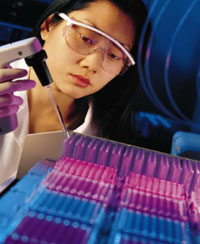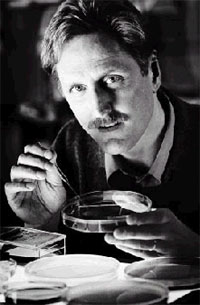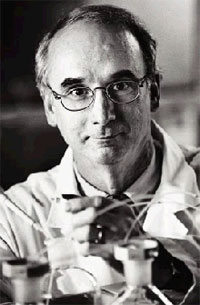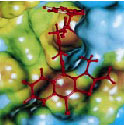|
|
 Jamin Chi, Scientist I, Wyeth-Ayerst Research |
Biotechnology opens a new world of pharmaceutical
discovery and development AHP is committed to remaining at the forefront of pharmaceutical research in the new millennium and is making significant investments in biotechnology. We are applying these technologies throughout the drug development process to speed up the discovery of proprietary targets, improve target validation, screen potential treatments more quickly, and design safer and more efficacious products in all three of our primary discovery platforms: small molecules, proteins and vaccines. We also have established strategic alliances with leading genomics and biotechnology companies around the world to supplement our internal resources, such as the agreements we signed in 2000 with Celera Genomics Group and Incyte Genomics, Inc. to access their extensive genetic databases, including the entire human genome sequence.  The benefits of these investments clearly are demonstrated by the innovative
products we have introduced in recent years and by our strong R&D pipeline.
In the articles that follow, three AHP research scientists describe in their
own words the impact of biotechnology on key research projects. Their stories
are representative of the efforts made by thousands of AHP's scientists
and technicians who are using new biotechnology tools to develop novel therapies
for challenging medical conditions that will benefit people throughout the
world.
The benefits of these investments clearly are demonstrated by the innovative
products we have introduced in recent years and by our strong R&D pipeline.
In the articles that follow, three AHP research scientists describe in their
own words the impact of biotechnology on key research projects. Their stories
are representative of the efforts made by thousands of AHP's scientists
and technicians who are using new biotechnology tools to develop novel therapies
for challenging medical conditions that will benefit people throughout the
world. |
"rhBMP-2 could fundamentally change the
clinical approach to bone regeneration and repair." John Wozney,
Ph.D., Assistant Vice President, Bone Biology, Wyeth-Ayerst
Research |
"Our research addresses the clinical problem of bone regeneration
in cases where bone either is lost or does not heal properly due to trauma.
Currently, surgeons attempt to regenerate and heal bone through the use
of medical devices, bone grafts or bone graft materials -all of which have
shortcomings. We wanted to find a biological solution that would stimulate
the body's own ability to form bone. We knew that bone growth is triggered by cellular activity during embryonic development or following a bone injury. However, it was only through the recent availability of advanced biotechnology tools that we were able to explore this process at a molecular level and begin to uncover the proteins that were involved. The successful application of this approach led to the discovery of the bone morphogenetic proteins, or BMPs - a family of proteins that helps to control the development of many tissue types, including bone. One of these proteins, BMP-2, appeared to be a very promising therapeutic candidate to induce bone formation. Biotechnology allowed us to derive the gene sequence of this protein, isolate and clone the sequence, and insert the BMP-2 gene  into a production cell to create a recombinant form of the protein - rhBMP-2
- for clinical testing. In clinical trials, we found that rhBMP-2 does indeed
induce bone formation in patients when applied locally. In February 2001,
our Pre-marketing Authorization Application was accepted by the U.S. Food
and Drug Administration for the use of rhBMP-2 in the treatment of long-bone
fractures that require open surgical management. The introduction of rhBMP-2
could fundamentally change the clinical approach to bone regeneration and
repair.
into a production cell to create a recombinant form of the protein - rhBMP-2
- for clinical testing. In clinical trials, we found that rhBMP-2 does indeed
induce bone formation in patients when applied locally. In February 2001,
our Pre-marketing Authorization Application was accepted by the U.S. Food
and Drug Administration for the use of rhBMP-2 in the treatment of long-bone
fractures that require open surgical management. The introduction of rhBMP-2
could fundamentally change the clinical approach to bone regeneration and
repair. In addition to bone growth, the BMP family of proteins holds tremendous potential for therapies involving many other types of tissues, including cartilage regeneration in osteoarthritis, tendon and ligament repair, and even the regeneration of lost function in the kidney or the brain. In fact, the discovery of BMPs has created a whole new area of basic research in tissue repair and regeneration. And biotechnology made it all possible." |
| "Biotechnology gives us the tools
to unravel the secrets of proteins." Gray Shaw, Senior Scientist and Laboratory Head, Wyeth-Ayerst Research  |
"Biotechnology has dramatically altered the process of drug discovery
in the 20 years since I entered the field as a molecular biologist. Today,
pharmaceutical development largely is centered on the study of proteins
and genes. Virtually every drug on the market either is a small molecule
that binds to a protein target, such as an enzyme, or is itself a protein.
Biotechnology gives us the tools to unravel the secrets of proteins to
find potential targets for therapies and provides the ability to reproduce
these protein targets for faster and more efficient testing of drugs to
change their function. |
| "Biotechnology helped us develop a potential
life-saving treatment more quickly." Kurt Steiner, Ph.D., Senior Director, Biological Research, Wyeth-Ayerst Research  |
"Biotechnology played a key role in the development of PTP-112,
a novel treatment for type II diabetes. In type II patients - who constitute
the vast majority of diabetics - the pancreas continues to produce insulin,
but the tissues in the body that normally react to insulin don't respond
properly or efficiently. As a result of this 'insulin resistance,' blood
sugar levels rise, and vital processes in the body that usually are triggered
by insulin don't respond appropriately, creating serious health problems
such as kidney failure, nerve damage and blindness. Until the 1990s, the standard treatments for type II diabetes stimulated release of insulin to compensate for resistance - an approach that often did not work effectively or led to secondary failure later as patients became less responsive over time. More recent treatments have targeted insulin resistance but have met with limited success. We wanted to get at the root of the problem and find a way to overcome insulin resistance.  Our
search for potential therapeutic targets focused on the PTPase family of
enzymes because they are directly involved in the process of 'turning off'
insulin receptors. With the help of biotechnology, we validated one specific
target enzyme, PTP-1B. We then created a humanized, recombinant version
of the protein to use with a high-throughput screen, rapidly testing tens
of thousands of compounds to find one that would inhibit the action of this
enzyme. Upon finding a promising candidate, we refined it using technologies
such as x-ray crystallography and molecular modeling along with creative
medicinal chemistry to enhance the structure of the compound for greater
efficacy. The result of that work was PTP-112, a small molecule with a novel
therapeutic action that keeps the insulin receptor 'turned on' and prolongs
the body's responses to insulin. PTP-112 is scheduled to begin Phase II
clinical trials during 2001. Our
search for potential therapeutic targets focused on the PTPase family of
enzymes because they are directly involved in the process of 'turning off'
insulin receptors. With the help of biotechnology, we validated one specific
target enzyme, PTP-1B. We then created a humanized, recombinant version
of the protein to use with a high-throughput screen, rapidly testing tens
of thousands of compounds to find one that would inhibit the action of this
enzyme. Upon finding a promising candidate, we refined it using technologies
such as x-ray crystallography and molecular modeling along with creative
medicinal chemistry to enhance the structure of the compound for greater
efficacy. The result of that work was PTP-112, a small molecule with a novel
therapeutic action that keeps the insulin receptor 'turned on' and prolongs
the body's responses to insulin. PTP-112 is scheduled to begin Phase II
clinical trials during 2001.Biotechnology helped us develop a potential life-saving treatment more quickly and efficiently than we could have in the past. It enhanced our ability to find a likely therapeutic target and allowed us to create a recombinant version for validation and testing - something that is possible only with these advanced capabilities. Perhaps most important, biotechnology provided us with the data we needed to move this product forward into clinical testing with greater confidence." |
|
|